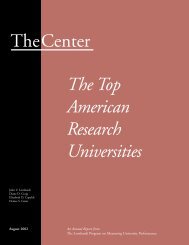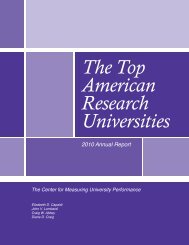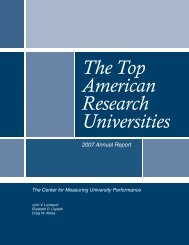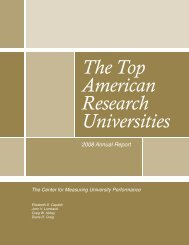TheCenter The Top American Research Universities
2005 - The Center for Measuring University Performance - Arizona ...
2005 - The Center for Measuring University Performance - Arizona ...
Create successful ePaper yourself
Turn your PDF publications into a flip-book with our unique Google optimized e-Paper software.
Other Measures ofUndergraduate QualityNational Merit and AchievementScholarsSource: <strong>The</strong> 2003-04 National Merit Scholarship CorporationAnnual Report, which reflects the 2004 freshman class.<strong>The</strong> National Merit Scholarship Corporation(NMSC) is an independent, nonprofit organizationthat awards scholarships to the nation’s outstandinghigh school seniors based on their academic achievement,qualifying test scores, high school principaland counselor recommendations, and their activities,interests, and goals. <strong>The</strong> NMSC names approximately16,000 National Merit Finalists each February. Ofthese, about one-half will receive a National Merit$2,500 Scholarship, a corporate-sponsored scholarship,or a college-sponsored scholarship.National Achievement Scholars are selected andfunded in a similar fashion and represent the nation’soutstanding African-<strong>American</strong> students. Ideally, theNational Hispanic Scholars Program should also beincluded in this category, but it does not track theenrollment of its scholarship winners. Should it doso in the future, we will include these students in<strong><strong>The</strong>Center</strong>’s data. In this study, Merit and Achievementscholarships are credited to the main campus ifthe NMSC Annual Report does not indicate a branchcampus.While the number of National Merit and NationalAchievement award winners in the entering class providesan indication of the attractiveness of a university’sundergraduate program to outstanding students,it is also an indicator that is sensitive to institutionalpolicies on financial aid. Because the number ofMerit Scholars is small, relatively small changes ininstitutional aid policies can have a significant impacton the number of National Merit Scholars enrollingin institutions. <strong>The</strong> average SAT score provides abroader-based and more reliable measure of overallundergraduate quality; for those reasons, we preferthe SAT scores to the number of National Merit andAchievement Scholars as an indicator of undergraduatequality.Institutional CharacteristicsMedical SchoolsSource: NCES IPEDS Completions Survey, MD degreesawarded between July 1, 2003, and June 30, 2004.Although the IPEDS Institutional CharacteristicsSurvey does have a “medical” field that indicateswhether an institution grants a medical degree, wechoose not to use its data because it includes medicaldegrees in Veterinary Medicine, Dentistry, and otherprofessional health-related fields. For our measure, wedetermined whether a particular campus awarded anyMD degrees during the academic year. If the institutiondid not submit any data to IPEDS for that year,we then looked at whether it was accredited by the<strong>American</strong> Medical Association to determine whetherthe institution has a medical school.Land Grant InstitutionsSource: National Association of State <strong>Universities</strong> and LandGrant Colleges.<strong>The</strong> first Morrill Act in 1862 appropriated federalfunds for universities to provide agricultural andtechnical education to their citizens. A second MorrillAct in 1890 expanded eligibility to include severalhistorically black colleges and universities, and in1994 several Native <strong>American</strong> tribal colleges wererecognized as land grant institutions. Today, there is atleast one land grant institution in each state and U.S.territory and in the District of Columbia. Of the 105institutions, most are public universities. Federal landgrant institutions receive both federal and state dollarsin support of their agricultural and extension activities.While land grant status technically applies to someuniversity systems, such as the University of Californiaand the University of Nebraska, for our study wedesignate as land grant institutions only those schoolsthat actually perform that function (e.g., UC-Berkeley,UC-Davis, UC-Riverside, Nebraska-Lincoln). Inthese cases, the land grant field will identify whetheran institution is part of a system-wide land grant andwhether the vast majority of the activity occurs onthat campus. For example, UC-Davis is coded as “Yes-System” while UCLA is coded as “No-System.” Weconsider the 1890 institutions as land grant institutions,but we identify them separately because they donot perform extension activities.<strong>The</strong> <strong>Top</strong> <strong>American</strong> <strong>Research</strong> <strong>Universities</strong> 2005 Page 233








